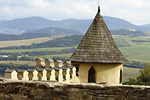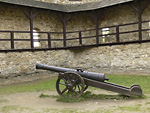Stará Ľubovňa and surroundings
Museum of Ľubovňa – The Castle of Ľubovňa



The most important monument of the town is the Ľubovňa Castle built about 1307 by the Hungarian magnate Omodeus Aba. Its history is connected with many important Hungarian and Polish noble families, the Drugeths, Kmitas, Lubomirski and Zamoyski. It was visited by many Hungarian and Polish sovereigns, e.g. Sigismund Luxemburg, Queen Maria, Vladislav II. Jagiełło, Ján Albrecht, Ján Kazimír and Ján Sobieski. The Polish crown jewels were being sheltered in the castle between 1655 and 1661.
The most valuable object in the castle is the Gothic main castle tower (bergfrid), which gives a beautiful view to the Tatras and the Three Crowns in Pieniny. The castle´s shape was markedly signed by the magnificent Renaissance reconstruction after the fire in 1553, initiated by the Polish king Sigismond August. The large Renaissance palace and the western bastion which come from this period, are dominating parts of the castle. The last large-scale reconstruction was realised since 1642 due to the Scepus mayor Stanislav Lubomirski. Since that time some more Baroque objects grew in the castle, such as the chapel, palace, entrance and the eastern bastion.
During the 90-minutes´ visit the visitors can see besides the valuable architecture the exhibitions of the construction´s development, historical exhibitions (Seven centuries of the Ľubovňa castle), guilds and crafts, period furniture as well as the exhibition dedicated to the last castle owners, the family Zamoyski (Zamoya). The traditional events during the highly-touristic season to animate the castle visits are the Hawkers´days, groups of historical fencing, theatre plays and concerts of classic music. At the foot of the castle, next to the open-air museum is a recently built medieval military camp where the visitors have opportunity to try shooting from a crossbow, horse-riding and many more interesting activities.






